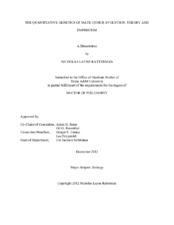| dc.description.abstract | The evolution of mate choice remains one of the most controversial topics within evolutionary biology. In particular, the coevolutionary dynamics between ornaments and mating preferences has been extensively studied, but few generalizations have emerged. From a theoretical standpoint, the nature of the genetic covariance built up by the process of mate choice has received considerable attention, though the models still make biologically unrealistic assumptions. Empirically, the difficulty of estimating parameters in the models has hindered our ability to understand what processes are occurring in nature. Thus, it is the goal of this dissertation to contribute to the field both theoretically and empirically.
I begin with a review of the evolution of mate choice and demonstrate how the lack of cross-talk between theoretical and empirical pursuits into studying mate choice has constrained our ability to extract basic principles. The review is followed by a new model of intersexual selection that relaxes some of the critical assumptions inherent in sexual selection theory. There are two empirical studies whose goal is to measure mating preference functions and genetic correlations in a way that can be related back to theory. Finally, I conclude by setting the stage for future endeavors into exploring the evolution of mate choice.
The results presented herein demonstrate four things: (i) a lack of communication between theoretical and empirical studies of mate choice; (ii) genetic drift plays a much larger role in preference evolution than previously demonstrated; (iii) genetic correlations other than those explicitly modeled are likely to be important in preference evolution; and (iv) variation in mating preferences can eliminate intersexual selection altogether. From these four findings it can be concluded that a tighter link between theory and empiricism is needed, with a particular emphasis on the importance of measuring individual-level preference functions. Models will benefit from integrating the specific phenotypes measured by empiricists. Experimentation will be more useful to theory if particular attention is paid to the exact phenotypes that are measured. Overall, this dissertation is a stepping stone for a more cohesive and accurate understanding of mate choice evolution. | en |


